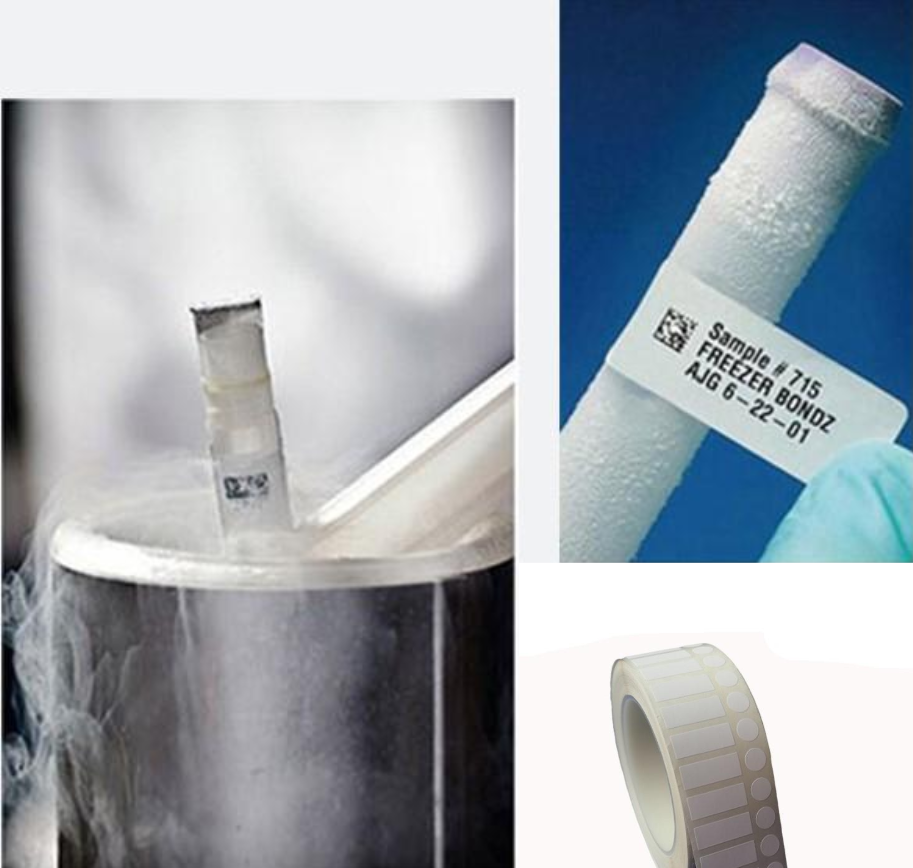
-196 ℃ liquid nitrogen label
-196° The C liquid ammonia label uses nylon cloth as the substrate, which is more flexible and suitable for the labeling requirements of some small cryovials. It is coated with imported low-temperature glue, which maintains good adhesion even in liquid nitrogen environment and can be stored in liquid nitrogen environment for a long time without warping or cracking
-196° The liquid nitrogen label is mainly used for identification in medical institutions or biological laboratories during research. The label surface material has good ductility and bendability, making it suitable for surfaces of various materials such as plastics, peeling test tubes, glass slides, etc. Its specially developed adhesive can also withstand high and low temperature tests from -196~150 ℃
Performance and advantages:
The white opaque film surface material with strong coverage and adhesive have strong low-temperature resistance, and can work for a long time in an environment of -196 ℃ on metal, paint, and plastic surfaces. It has good adhesion and is easy to print. It has good compatibility with various types of carbon. It is suitable for safety and sealing labels, warning labels, and identification labels in low-temperature environments
Scope of application:Low temperature storage plastic test tubes, glass slides, experimental orifice plates, experimental sleeves, slightly rough surfaces

Low temperature resistant label
Low temperature resistant labels are a type of label that can maintain strong adhesion and will not easily fall off even in low temperature environments. Due to its ability to withstand extreme temperatures, it is specifically used for various frozen storage applications, including liquid nitrogen, freezing, and ultra-low temperature freezing. Currently, low-temperature resistant labels are mainly used in fields such as pharmaceuticals, chemicals, and refrigeration. Among them, medicine, as a field related to people's health, has very high requirements for low-temperature resistant labels. As a well-known adhesive and tape manufacturer, Gaofu Code provides medical low-temperature resistant label products that can meet various demanding needs.
For example, high coding and low temperature 3M labels. It can be used for pasting at room temperature ranging from 5 ℃ to 49 ℃, stored in a low-temperature environment of -40 ℃, and meets the safety certification of CONEG and FDA, with good durability, adhesion, and moisture resistance. Suitable for use in the harsh environment that blood bag tracking labels may experience;
High coding low temperature label. After being pasted on a metal or paper surface at room temperature and left for a period of time, it can withstand a low temperature test of -80 ℃. Suitable for low-temperature/cold chain vaccine labeling.
Nylon fabric low temperature resistant label
Nylon fabric low-temperature resistant label is a label solution designed specifically for low-temperature environments, characterized by the use of nylon fabric as the substrate. Nylon fabric is renowned for its high strength, excellent impact resistance, and outstanding low-temperature resistance, which enables nylon fabric low-temperature labels to maintain stability and reliability under extreme low-temperature conditions.
Specifically, nylon fabric low-temperature resistant labels can withstand liquid nitrogen environments as low as -196 ℃ without falling off, becoming brittle, or deforming. They are usually coated with special low-temperature resistant adhesive to ensure strong adhesion even in low-temperature environments. In addition, these labels also have excellent solvent resistance, biochemical corrosion resistance, UV light resistance, and weather resistance, which can maintain clear and readable label information in various harsh environments.
Nylon cloth low-temperature resistant labels have been widely used in various industries such as medicine, biological laboratories, food, and chemical engineering, especially in the labeling of biological samples and reagents that require long-term storage in liquid nitrogen. These labels not only ensure the accuracy and traceability of information, but also maintain stable performance in low-temperature environments, providing reliable guarantees for scientific research and production.
We offer comprehensive technical support, including free professional labeling solutions, advice on label materials and adhesive selection, as well as online/offline assistance from professional software and hardware engineers. Service email: andy@ownlikes.cn. In pre-sales, we leverage our extensive experience in specialty labeling projects to provide clients with the most suitable hardware solutions. Additionally, all our label barcode printers and scanners come with a three-year free warranty, demonstrating our confidence in our products.




